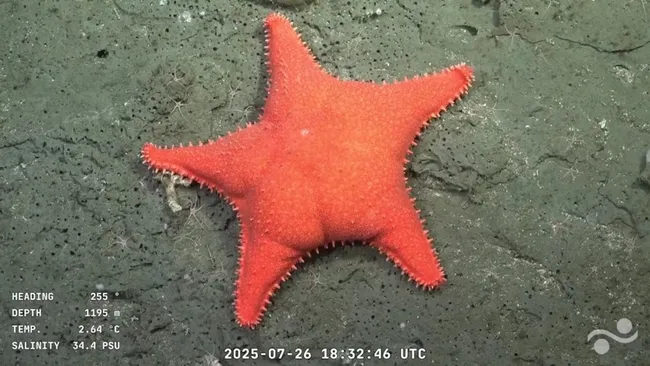Researchers have captured footage of a “big-butt seastar” off the coast of Argentina that looks like Patrick Star from “SpongeBob SquarePants.”
Deep-Sea Discoveries off Argentina Reveal Dozens of New Species — Including a Viral “Big-Butt” Starfish
An ambitious underwater expedition off the coast of Argentina has revealed an extraordinary variety of never-before-seen marine creatures — including one unexpected internet sensation: a rotund sea star nicknamed the “big-butt starfish,” likened to SpongeBob SquarePants’ Patrick Star.
Since July 23, researchers aboard the Schmidt Ocean Institute’s research vessel have been exploring the Mar del Plata submarine canyon, a largely uncharted deep-sea environment in the South Atlantic. Their remotely operated vehicle (ROV), SuBastian, has captured high-definition footage of over 40 newly discovered species, many of which were livestreamed online with expert commentary and real-time public interaction.
Among the diverse marine life caught on camera are translucent fish, flamboyant rays, vividly hued corals, and carnivorous sponges—a rare find in this part of the ocean. But one creature has captured the imagination of viewers around the globe.
Meet the “Estrella Culona”
A starfish from the Hippasteria genus has gone viral for its plump, rounded appearance, earning it the affectionate nickname “estrella culona” — Spanish for “big-butt star”. Social media users were quick to point out its uncanny resemblance to Patrick Star’s posterior, turning the footage into a humorous online phenomenon.
While the starfish’s chubby form has sparked laughter, scientists say there’s likely a biological explanation. It may simply be well-fed, as these sea stars are known carnivores. Another theory suggests the “gluteal” shape is a result of gravity pulling the body downward as it clings to a vertical surface, creating an optical illusion.
Of course, starfish don’t have rear ends. As Mariela Romanelli, a biologist and curator at Argentina’s National Museum of Natural Sciences, explained, the starfish’s mouth is located on the underside, while its anus is centered on the top side — far from the internet’s favorite feature. “The resemblance to Patrick’s butt is undeniably funny,” she admitted in a Spanish-language interview with Infobae.
More Than Just Laughs: A Treasure Trove of Marine Life
The now-famous sea star wasn’t the only discovery to delight scientists and viewers. Another standout was a purple sea cucumber from the Benthodytes genus, dubbed “Batatita” (or “Little Sweet Potato”) for its soft, squat shape and rich violet color. It was successfully collected by the ROV and remains in good health at the surface.
In total, the team has recorded at least 25 species of fish, both bony and cartilaginous, alongside various invertebrates. Many of these creatures are uniquely adapted to the crushing pressure and pitch-black environment of depths nearing 13,100 feet (4,000 meters).
This marks one of the first times a deep-sea livestream from these depths has been broadcast directly to the public. The ongoing expedition is being led jointly by Argentina’s National Scientific and Technical Research Council (CONICET) and the Schmidt Ocean Institute.
The livestream continues until August 10 and is available on the Schmidt Ocean Institute’s YouTube channel, offering viewers a rare chance to witness the wonders of the deep ocean — and maybe even spot the next viral deep-sea superstar.
